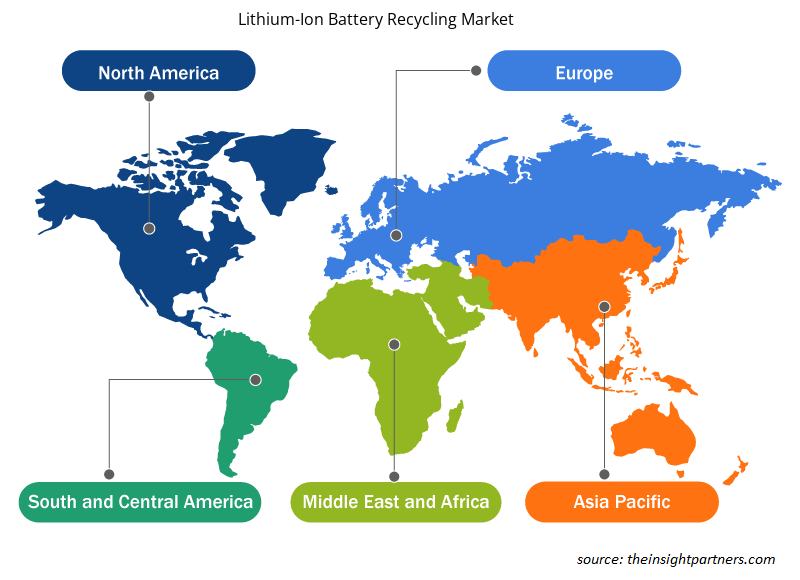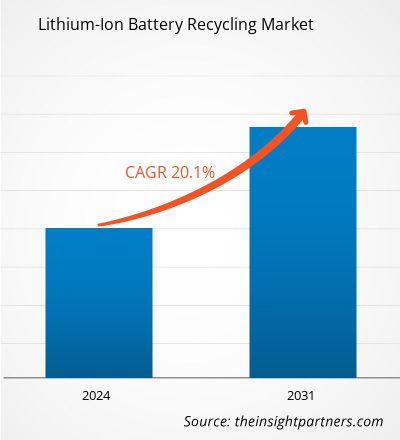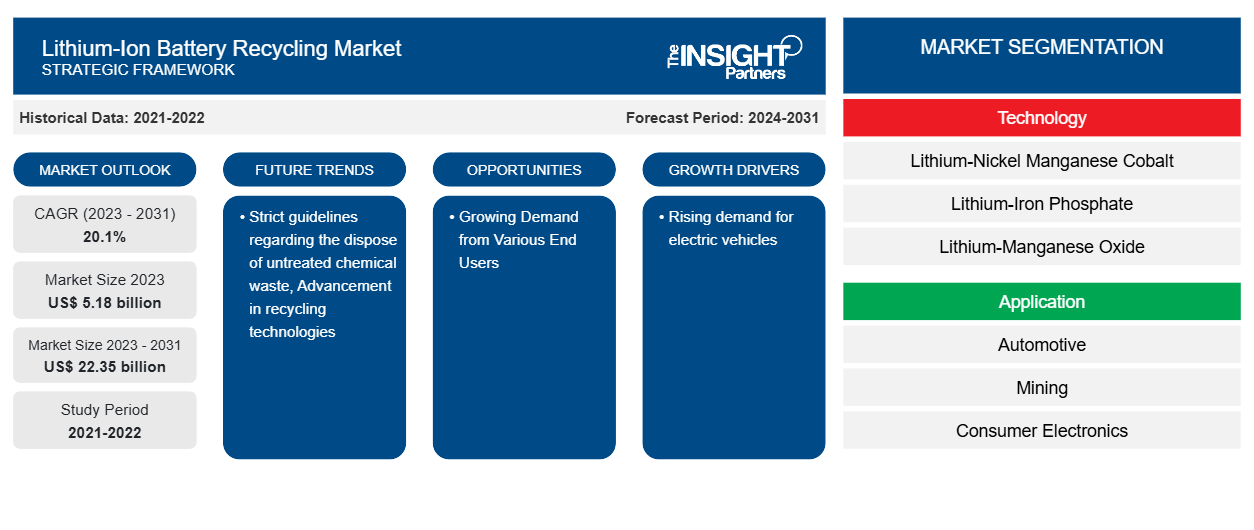리튬 이온 배터리 재활용 시장 규모는 2023년 51억 8,000만 달러에서 2031년 2,235억 달러로 성장할 것으로 예상되며, 2023년에서 2031년 사이에 연평균 성장률 20.1%로 성장할 것으로 추산됩니다. 처리되지 않은 화학 폐기물의 폐기와 재활용 기술의 발전에 대한 엄격한 지침은 리튬 이온 배터리 재활용 시장의 주요 추세로 남을 가능성이 높습니다.
리튬이온 배터리 재활용 시장 분석
자동차 부문은 최근 몇 년 동안 재활용 리튬 이온 배터리에 대한 수요가 엄청나게 증가했으며, 특히 미국, 독일, 스웨덴, 노르웨이, 네덜란드, 중국과 일부 동남아시아 개발도상국에서 그렇습니다. IEA는 2020년과 비교하여 전기 자동차 판매량이 2021년에 거의 두 배인 660만 대(또는 거의 9%)로 증가했으며, 전체적으로 1,650만 대의 전기 자동차가 도로에 있다고 보고했습니다. 또한 IEA는 2030년까지 도로에 3억 대 이상의 전기 자동차가 있을 것으로 예상하며 , 이는 리튬 이온 배터리 재활용이 증가할 가능성이 높습니다. 본질적으로 이 지역 개발도상국의 전기 자동차의 긍정적인 환경적 영향에 대한 소비자 지식이 증가함에 따라 산업 성장이 촉진될 것으로 예상됩니다. 제조업체는 자동차에서의 수요를 충족하기 위해 사용한 리튬 이온 배터리 재활용에 집중하고 있습니다.
리튬이온 배터리 재활용 시장 개요
리튬 이온 배터리(LIB)는 다양한 응용 분야에서 전력 생성을 지원하기 위해 전극 및 촉매와 같은 구성 요소를 포함하는 전기화학 셀의 한 유형입니다. 양극 및 음극 튜브에는 유한한 매장량과 높은 재판매 가격을 가진 다양한 귀금속이 포함되어 있습니다. 결과적으로 리튬 이온 배터리의 재활용 프로세스는 전극 구성에서 수집된 원자재를 회수하여 판매하여 전체 프로젝트 비용과 영향을 낮추는 데 사용됩니다. 이러한 원인은 리튬 이온 배터리 재활용 시장 의 성장에 도움이 될 것입니다.
다양한 응용 분야에서 리튬 이온 배터리 사용이 증가함에 따라 기본 금속의 공급이 제한될 수 있다는 우려가 제기되었습니다. 이 금속의 채굴은 화학 물질 누출로 인한 수질 오염을 포함하여 환경에 부정적인 영향을 미칩니다. 이로 인해 리튬 이온 배터리 재활용이 최근 증가했습니다. 또한 현재 리튬과 유사한 특성을 제공하는 다른 재료가 없기 때문에 배터리 생산업체는 다양한 용도에 적합한 양의 금속을 배터리에 제공하기 위해 리튬 배터리의 재활용에 점점 더 주력하고 있습니다. 이와 관련하여 독일 화학 회사 BASF는 2021년 6월 슈바르츠하이데에 있는 양극 활성 물질(CAM) 시설에서 새로운 배터리 재활용 및 프로토타입 생산 공장을 건설할 계획이라고 발표했습니다. 리튬 이온 배터리가 사용 수명이 다하면 이 회사는 향상된 방법을 사용하여 코발트, 망간, 리튬 및 니켈을 추출할 계획입니다.BASF announced plans in June 2021 to begin construction of a new battery recycling and prototype production plant at its cathode active material (CAM) facility in Schwarzheide. When lithium-ion batteries reach the end of their useful life, the company intends to extract cobalt, manganese, lithium, and nickel using an enhanced method.
귀하의 요구 사항에 맞게 이 보고서를 사용자 정의하세요
이 보고서의 일부 또는 국가 수준 분석, Excel 데이터 팩을 포함하여 모든 보고서에 대한 사용자 정의를 무료로 받을 수 있으며 신생 기업 및 대학을 위한 훌륭한 혜택과 할인 혜택을 이용할 수 있습니다.
-
이 보고서의 주요 시장 동향을 알아보세요.이 무료 샘플에는 시장 동향부터 추정 및 예측까지 다양한 데이터 분석이 포함됩니다.
리튬 이온 배터리 재활용 시장 동인 및 기회
전기 자동차 수요 증가로 시장 성장 촉진
전기 자동차의 인기 상승은 리튬 이온 배터리 재활용 시장을 이끄는 주요 요인 중 하나입니다. 제조 및 판매되는 전기 자동차의 양이 증가함에 따라 수명 주기가 끝난 배터리를 재활용해야 할 필요성이 점점 더 중요해졌습니다. 환경 문제와 온실 가스 배출의 영향에 대한 집단적 인식으로 인해 전 세계적으로 더 깨끗하고 지속 가능한 교통 옵션을 향한 움직임이 일어나고 있습니다. 전기 자동차는 제로 배출로 인해 기존 내연 기관에 대한 실행 가능한 대안으로 입증되었습니다. 배터리 기술 과 전기 자동차 설계의 지속적인 개선으로 주행 범위가 늘어나고 충전 시간이 단축되었으며 전기 자동차의 전반적인 성능이 향상되었습니다. 이로 인해 전기 자동차가 더 실용적이고 더 광범위한 인구에게 매력적이 되어 수요가 증가했습니다. 전기 자동차에서 리튬 이온 배터리의 유용성이 증가하고 있습니다. 낮은 에너지 효율, 오염 및 소비자 수용과 같은 다양한 요인으로 인해 전기 자동차의 활용이 증가하고 있으며, 이는 리튬 이온 배터리 채택을 촉진하는 요인 중 하나입니다. 고급 배터리 기술의 개발과 이러한 리튬 이온 배터리의 최소한의 유지 관리 요구 사항도 전기 자동차의 성장에 기여하는 요인입니다. 따라서 리튬이온 배터리 사용 증가로 인해 리튬이온 배터리 재활용 시장도 꾸준히 성장할 것으로 전망된다.
BILITI Electric의 추산에 따르면 미국에는 약 300만 대(55,555)의 전기 자동차가 있으며, 이는 도로에 있는 총 차량 수의 약 1%입니다. 2022년에만 55,555개 회사가 약 442,000대의 전기 자동차를 생산했습니다. 이는 자동차 제조업체의 전기 자동차 생산이 상당히 증가했음을 나타냅니다.
다양한 최종 사용자의 수요 증가 - 리튬 이온 배터리 재활용 시장의 기회
전기 및 전자 분야는 태블릿, 컴퓨터, 휴대전화 및 기타 전자 기기에 사용되기 때문에 리튬 이온 배터리를 가장 많이 사용하는 분야 중 하나입니다. 이러한 에너지원에 대한 수요는 전기 및 전자 산업의 확장으로 인해 증가했으며, 특히 중국, 인도, 일본과 같은 성장하는 APAC 국가에서 증가했습니다. 또한 재활용 리튬 이온 배터리 시장은 최종 사용자 산업의 수요 증가로 인해 향후 몇 년 동안 확대될 가능성이 큽니다. 또한 여러 정부가 고급 배터리 재활용 기술을 도입하고 있습니다. 예를 들어, 2023년 6월, 미국 에너지부(DOE)는 소비자 품목에서 배터리를 재활용하기 위한 1억 9,200만 달러 이상의 추가 자금 지원, 첨단 배터리 연구 및 개발(R&D) 협업 형성, 2019년에 제정된 리튬 이온 배터리 재활용 상의 지속을 발표했습니다. 2027년까지 전기 자동차(EV) 및 고정형 에너지 저장에 대한 수요가 10배 이상 증가할 것으로 예상됨에 따라 중요 재료에 대한 안전하고 회복성 있는 순환형 국내 공급망을 지원하기 위해 지속 가능하고 저렴한 소비자용 배터리 재활용에 투자하는 것이 중요합니다.
리튬 이온 배터리 재활용 시장 보고서 세분화 분석
리튬 이온 배터리 재활용 시장 분석에 기여한 핵심 부문은 기술과 응용 분야입니다.
- 리튬 이온 배터리 재활용 시장은 기술에 따라 리튬-니켈-망간-코발트, 리튬-철-인산, 리튬-망간산화물, 리튬-티타네이트산화물, 리튬-니켈-코발트-알루미늄산화물로 구분됩니다.
- 리튬 이온 배터리 재활용 시장은 응용 분야별로 자동차, 광산, 가전제품, 산업 및 전력으로 구분됩니다.
지역별 리튬이온 배터리 재활용 시장 점유율 분석
- 리튬 이온 배터리 재활용 시장은 북미, 유럽, 아시아 태평양(APAC), 중동 및 아프리카(MEA), 남미 및 중미의 5개 주요 지역으로 세분화됩니다. APAC가 2023년 시장을 지배했습니다.
- GS Yuasa Corporation, Umicore SA 등 지역 전역의 혁신적이고 저명한 공급업체의 존재는 시장의 지배적인 확장에 기인합니다. 상업용 및 주거용 애플리케이션을 위한 전기 자동차 및 에너지 저장 시스템(ESS)과 같은 새롭고 매력적인 시장의 출현은 LIB에 대한 수요를 견인하고 있습니다. 게다가 풍력, 태양광, 수력과 같은 재생 에너지와 ESS를 함께 사용하는 것은 그리드 안정성을 높이고 LIB 부문을 발전시키는 데 기술적으로나 경제적으로 필요합니다.
리튬 이온 배터리 재활용 시장 지역 통찰력
Insight Partners의 분석가들은 예측 기간 동안 리튬 이온 배터리 재활용 시장에 영향을 미치는 지역적 추세와 요인을 철저히 설명했습니다. 이 섹션에서는 북미, 유럽, 아시아 태평양, 중동 및 아프리카, 남미 및 중미의 리튬 이온 배터리 재활용 시장 세그먼트와 지리에 대해서도 설명합니다.

- 리튬 이온 배터리 재활용 시장에 대한 지역별 특정 데이터 얻기
리튬이온 배터리 재활용 시장 보고서 범위
| 보고서 속성 | 세부 |
|---|---|
| 2023년 시장 규모 | 51억 8천만 달러 |
| 2031년까지 시장 규모 | 223억 5천만 달러 |
| 글로벌 CAGR (2023-2031) | 20.1% |
| 역사적 데이터 | 2021-2022 |
| 예측 기간 | 2024-2031 |
| 다루는 세그먼트 |
기술로
|
| 포함된 지역 및 국가 |
북아메리카
|
| 시장 선도 기업 및 주요 회사 프로필 |
|
시장 참여자 밀도: 비즈니스 역학에 미치는 영향 이해
리튬 이온 배터리 재활용 시장은 소비자 선호도의 변화, 기술 발전, 제품의 이점에 대한 인식 증가와 같은 요인으로 인해 최종 사용자 수요가 증가함에 따라 빠르게 성장하고 있습니다. 수요가 증가함에 따라 기업은 제품을 확장하고, 소비자의 요구를 충족하기 위해 혁신하고, 새로운 트렌드를 활용하여 시장 성장을 더욱 촉진하고 있습니다.
시장 참여자 밀도는 특정 시장이나 산업 내에서 운영되는 회사나 기업의 분포를 말합니다. 주어진 시장 공간에 얼마나 많은 경쟁자(시장 참여자)가 존재하는지 그 규모나 총 시장 가치에 비해 나타냅니다.
리튬 이온 배터리 재활용 시장에서 활동하는 주요 회사는 다음과 같습니다.
- 에코뱃 테크놀로지스
- 아메리칸 망간 주식회사 (RecycLico Battery Material Inc.)
- 포르툼
- 젬 주식회사
- 국제 금속 회수 회사(INMETCO)
- 리사이클(주)
면책 조항 : 위에 나열된 회사는 어떤 특별한 순서에 따라 순위가 매겨지지 않았습니다.

- 리튬 이온 배터리 재활용 시장의 주요 업체 개요를 알아보세요
리튬 이온 배터리 재활용 시장 뉴스 및 최근 개발
피어 투 피어 보험 시장은 1차 및 2차 조사 이후의 정성적, 정량적 데이터를 수집하여 평가합니다. 여기에는 중요한 기업 간행물, 협회 데이터 및 데이터베이스가 포함됩니다. 다음은 리튬 이온 배터리 재활용 시장의 개발 목록입니다.
- 2024년 2월, Omega Seiki Private Ltd(OSPL)는 리튬 이온 배터리 재활용을 위해 Attero와 계약을 체결했다고 발표했습니다. 이 협력에 따라 OSPL은 전자 폐기물 관리 회사 Attero와 함께 향후 3~4년 동안 100MWh 이상의 배터리를 재활용할 계획입니다.
(출처: 오메가세이키 주식회사, 보도자료)
- 2024년 5월, 리튬 금속 배터리 제조업체인 보스턴의 SES AI Corp.는 리튬 금속 배터리를 위한 "최첨단" 재활용 기술을 개발하기 위해 우스터 폴리테크닉 연구소(WPI)에서 새로운 연구 이니셔티브에 자금을 지원할 계획이라고 발표했습니다.
(출처: SES AI Corp, 보도자료)
리튬 이온 배터리 재활용 시장 보고서 범위 및 제공물
"리튬 이온 배터리 재활용 시장 규모 및 예측(2021-2031)"은 아래에 언급된 영역을 포괄하는 시장에 대한 자세한 분석을 제공합니다.
- 범위에 포함된 모든 주요 시장 세그먼트에 대한 글로벌, 지역 및 국가 수준의 시장 규모 및 예측
- 동인, 제약 및 주요 기회와 같은 시장 역학
- 주요 미래 트렌드
- 자세한 PEST/포터의 5가지 힘과 SWOT 분석
- 주요 시장 동향, 주요 업체, 규정 및 최근 시장 동향을 포괄하는 글로벌 및 지역 시장 분석
- 시장 집중도, 히트맵 분석, 유명 기업 및 최근 개발 사항을 포함하는 산업 환경 및 경쟁 분석
- 자세한 회사 프로필
- 과거 분석(2년), 기준 연도, CAGR을 포함한 예측(7년)
- PEST 및 SWOT 분석
- 시장 규모 가치/거래량 - 글로벌, 지역, 국가
- 산업 및 경쟁 환경
- Excel 데이터세트
최근 보고서
관련 보고서
사용 후기
구매 이유
- 정보에 기반한 의사 결정
- 시장 역학 이해
- 경쟁 분석
- 고객 인사이트
- 시장 예측
- 위험 완화
- 전략 기획
- 투자 타당성 분석
- 신흥 시장 파악
- 마케팅 전략 강화
- 운영 효율성 향상
- 규제 동향에 발맞춰 대응























 무료 샘플 받기 - 리튬 이온 배터리 재활용 시장
무료 샘플 받기 - 리튬 이온 배터리 재활용 시장